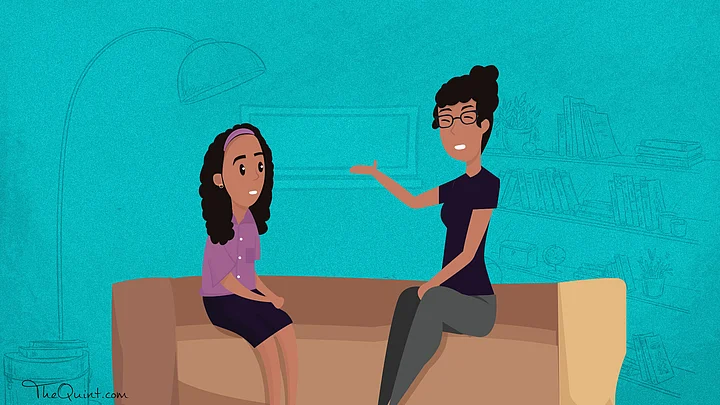While news around child abuse is largely met with anger and outrage, what often slips through the cracks is the need for larger, systemic and long term awareness on child sexual abuse for all — parents, teachers and communities.
As parents grapple with the new normal, WhatsApp groups are sharing videos of how to talk to your child about safe and unsafe touch.
But experts say while these videos are important, let’s not shift the responsibility of reporting sexual abuse on to the child.
Child sexual abuse in India is an urban reality and the numbers are staggering.
Too caught up to read? Listen to the story:
A survey of over 45,000 children in the 12-18 age group, across 26 states in the country, revealed that one in every two children is a victim of child sexual abuse. Most never report it. What’s worse, in most cases the abuser is known to the child.
You want to empower both yourself and your child with tools to deal with any situation and at all ages.
First Steps
Anuja Gupta from Rahi Foundation says first step for the parents, even before they talk to the child about safe and unsafe touch, is to create an environment at home where conversations take place.
The first step for parents is to acknowledge that abuse and incest are part of their reality. They need to build this in their thinking.
Parents have to first talk to their child about feelings. What makes them FEEL good, what are they comfortable with, what makes them happy and then what makes them sad and uncomfortable. They need to give their children the language to articulate their thoughts.
They then need to build in a conversation about what makes them feel safe or unsafe before veering the conversation to body parts and inappropriate touching.
Teaching them about body parts and what is private is important. Experts suggest you don’t shy away from using actual words for body parts like vagina, penis.
Anuja says in India children are not taught to be assertive.
To a 3 to 5-year-old, you need to empower them to say NO. It’s okay to say no to shaking hands, kissing or hugging. YOU are the BOSS of your body.
And while you teach them to respect their elders, you also have to tell them to shout and scream if that elder hurts you.
We presume the safe circle of children includes parents, grandparents and uncles and aunts. We don’t acknowledge that very often it’s these respected elders who are the abusers.Anuja Gupta, Rahi Foundation
The onus of teaching our children cannot lie only with parents or schools. Without a community level effort, children will not find safe spaces where they can articulate what they have gone through.
In the below video by the team of Satyamev Jayate, Aamir Khan talks to children about good touch-bad touch.
Not All Children Will Shout or Scream
That’s because in most cases, pedophiles are known to the child and have spent time ‘grooming’ them. Experts say they sometimes spend months grooming the child, showing them videos, getting close to them and creating a special bond. They make the child believe what they are doing is perfectly normal and it’s their secret, not to be spoken about.
It then becomes important that you don’t ignore the signs. Listen to them, don’t dismiss their concerns. As a parent you should also know WHAT to pick up on. Your support is the single most important factor in their recovery.
The below video, My Body Belongs to Me, perfectly articulates what a child will understand.
Watch Out for These Red Flags
Red flags in cases of child sexual abuse are categorized as physical, sexual, behavioural. Physical signs are easy to pick on. Is your child hurt, is he or she complaining about stomach ache, pain in their private parts, bleeding, etc?
Sexual signs are tougher to pick on. Is your child masturbating more than what is normal, indulging in sexualised play with dolls, is their sexual knowledge consistent to their peers?
Anuja says children express most with their drawings and parents should pay special attention to them. Most children will normally draw stick figures. Do the bodies they draw have breasts, a dark area between the legs?
Behavioral signs include:
- Withdrawal from friends or usual activities
- Changes in behavior — such as aggression, anger, hostility or hyperactivity — or changes in school performance
- Depression, anxiety or unusual fears or a sudden loss of self-confidence
- Frequent absences from school or reluctance to ride the school bus
- Rebellious or defiant behavior
- Attempts at suicide
This video by Poddar Jumbo Kids uses puppets to educate children about Good Touch, Bad Touch.
Its important that your child gets immediate medical attention, counseling and support, that the child feels loved and supported even when they are going through the most intense, negative feelings.
It’s difficult to draw out a child if he or she doesn’t feel comfortable around his parents and teachers. Unless we create community level safe places for children to talk, each story will remain just an outrage that died with the next headline.
Reach out to a safe list of mental health professionals collated by thehealthcollective.in.
(At The Quint, we question everything. Play an active role in shaping our journalism by becoming a member today.)
